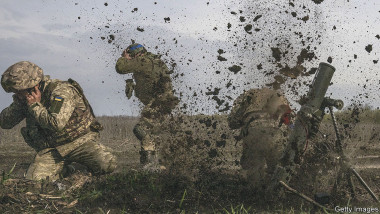The war in Ukraine shows how technology is changing the battlefield
Submission Statement
This article is the first in a series by the Economist focused on lessons learned from the Ukraine war. The articles are written for a layman audience, but even dedicated watchers can derive value from the interviews and novel information sprinkled throughout. I plan on posting them in sequence here, and the full set of 7 articles can be found here.
The first article takes a look at the impacts that new technologies have had on the current state of warfare. Ukraine has taken the reconnaissance-strike complex–sensors, shooters, and the networks that connect them–and elevated it to the level of doctrine. The article itself mentions several times their integration of drones and networking exceeds that of even NATO armies. Thus far, however, the massive leaps in technology and integration have failed to deliver on the lightning-fast, maneuver-dominated warfare promised by the likes of Desert Storm. This has resulted in a debate over the true impacts of wartime technology. I’ve seen this balance oversimplified in both directions. Users are equally prone to either declaring networked drones the end-all, be-all of weapons technology or concluding they are window dressing on the inevitability of attritional warfare. The author strikes a more nuanced position, noting that precision and the transparent battlefield alternately counter and magnify the effects of mass. Drones, like artillery, are valuable tools in a broader toolkit. Their success or failure on the battlefield ultimately comes down to the ingenuity and willpower of the humans making and wielding them.
Shashank Joshi is The Economist‘s defence editor. Prior to joining The Economist in 2018, he served as Senior Research Fellow at the Royal United Services Institute (RUSI) and Research Associate at Oxford University’s Changing Character of War Programme.
Ukraine serves as a rejoinder to the idea that technology always trumps mass: that quality can replace quantity. General Sir Patrick Sanders, head of the British army, put it acerbically last year: “You can’t cyber your way across a river.”
But the paradox of the war is that mass and technology are intimately bound together. Even the artillery war shows this. Weeks before the invasion, America sent Ukraine Excalibur shells. Inside each was a small, rugged chip that could receive gps signals from America’s constellation of navigation satellites. Whereas Russia often relied on barrages over a wide area, Ukrainian gunners could be more precise. Such rounds were “disproportionately effective”, noted a study published by Mr Watling and his colleagues at rusi, drawing on data from Ukraine’s general staff. Not only did they take out targets more reliably; they reduced the number of shells needed, lowering the logistical burden (shells are heavy).
This digitisation of hardware reflects a collision of old and new ways of war. Much kit Ukraine has received is vintage, such as American howitzers or Soviet missile launchers designed before the Cuban missile crisis, or is stripped of sensitive components. Ukraine is pioneering “the ability to turn it from a dumb piece of cold-war metal into something that’s genuinely networked and part of this algorithmic warfare,” says a foreign adviser in Kyiv. “It is maddening,” noted James Heappey, a junior British defence minister, that “I am providing to the Ukrainians…capability that we’re still years away from getting in the British armed forces.”
Ukrainian planners, in contrast, waged “data-driven combat” at a level of “speed and precision that nato has not yet achieved”, concludes a report by Nico Lange, a former chief of staff at Germany’s defence ministry. Sometimes that has been down to tools like Kropyva and Delta. Firms such as Palantir, an American tech company, have used cutting-edge ai to help Ukraine find high-value targets. But data-driven warfare can be quietly prosaic, too. A Ukrainian police officer explains that last year his units were locating Russian troops simply by intercepting 1,000 conversations a day (the figure is now higher). If they found a general, the details were shared in an ad hoc WhatsApp group. “We were connected to the people who were literally bombing.”
Precision warfare can counter some advantages of mass: Ukraine was outnumbered 12 to one north of Kyiv. It can also complement mass. Software-based targeting saves around 15-30% in shells, according to sources familiar with the data. But what precision cannot do, says Michael Kofman of the Centre for Naval Analyses (cna), a think-tank, is substitute for mass. The idea behind the Soviet reconnaissance-strike complex or America’s rma was to win by paralysing the enemy, not wearing him down. But there seems to be no escape from attrition. War on the cheap is an illusion. Many people expected Russia’s invasion to be “a second Desert Storm”, says Andrew Krepinevich, an American defence official who pioneered the idea of the rma in the 1990s. “What we got was a second Iran-Iraq war.”

Add comment